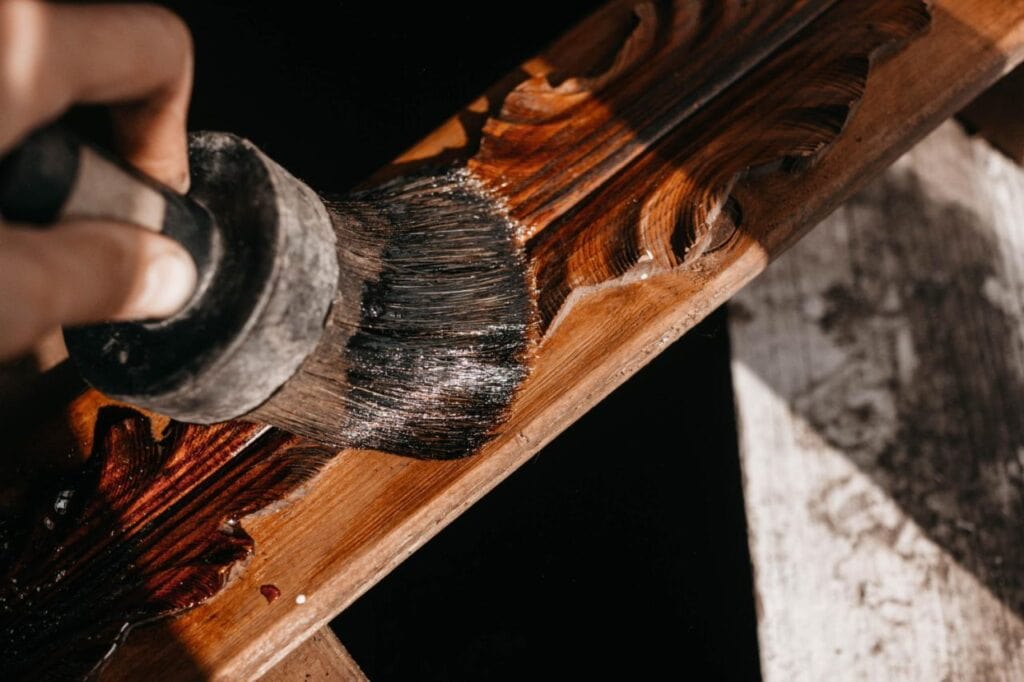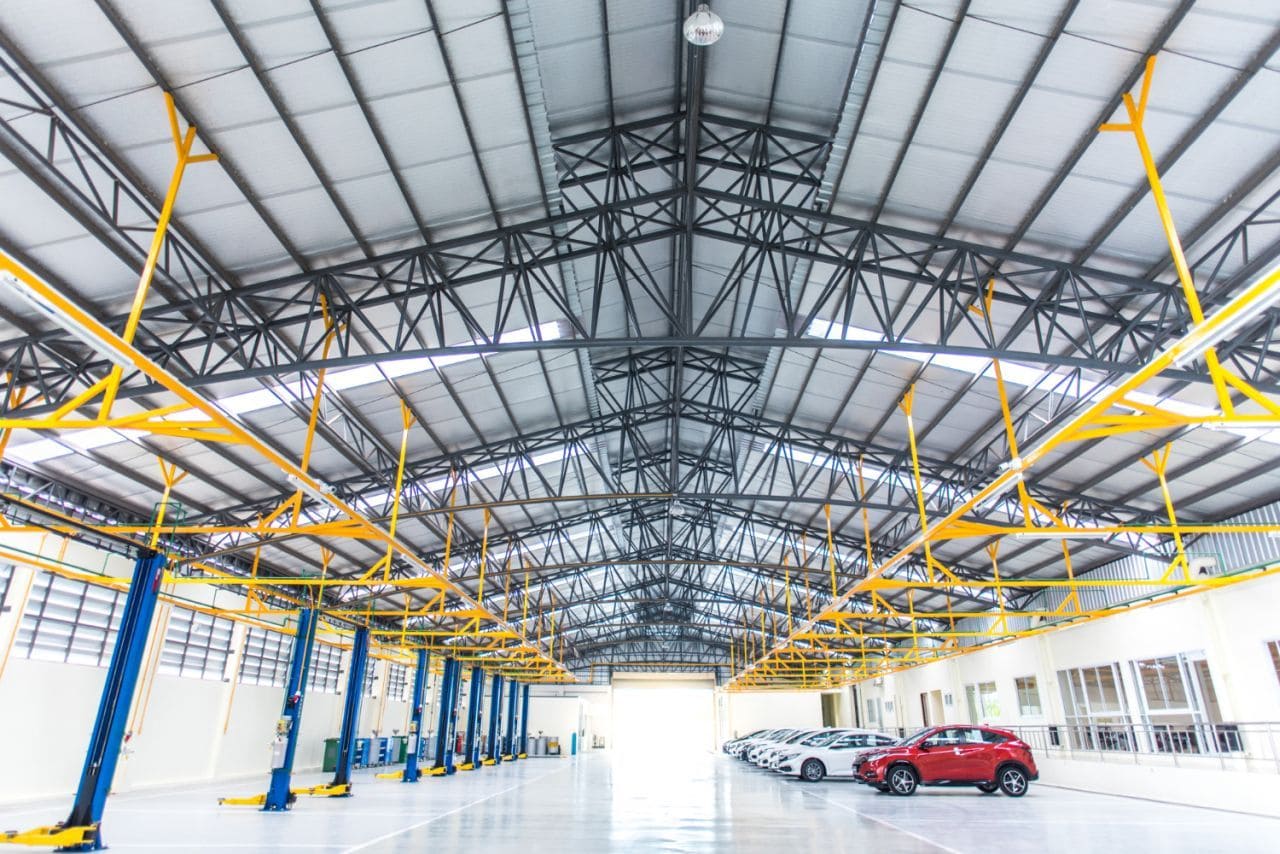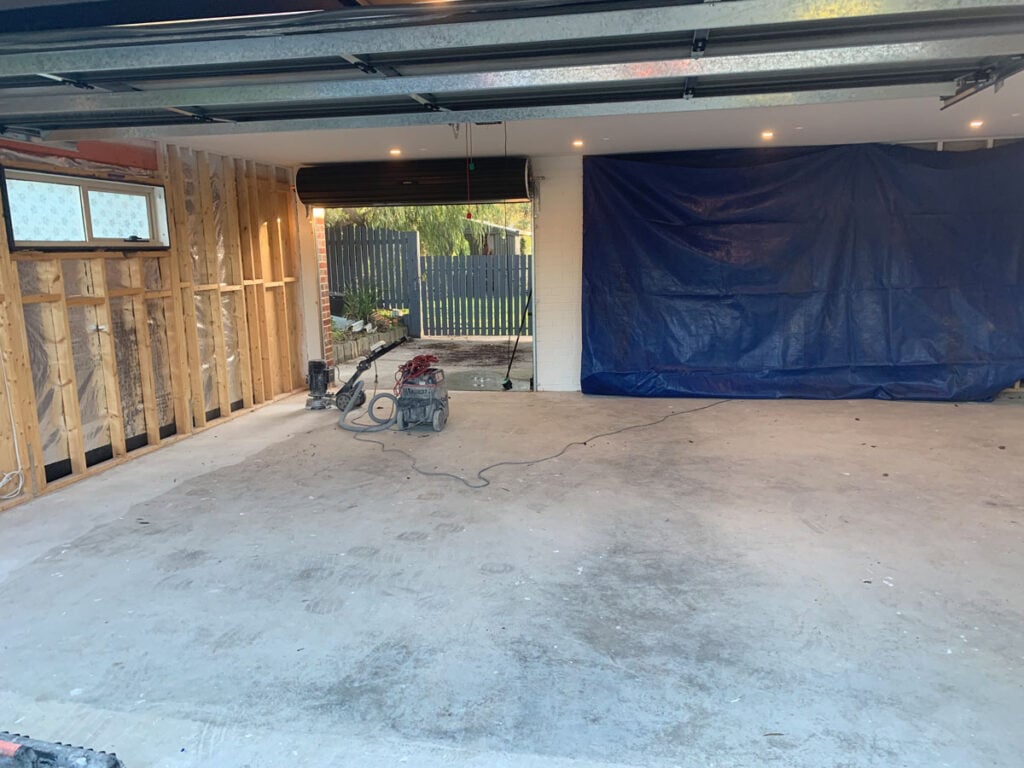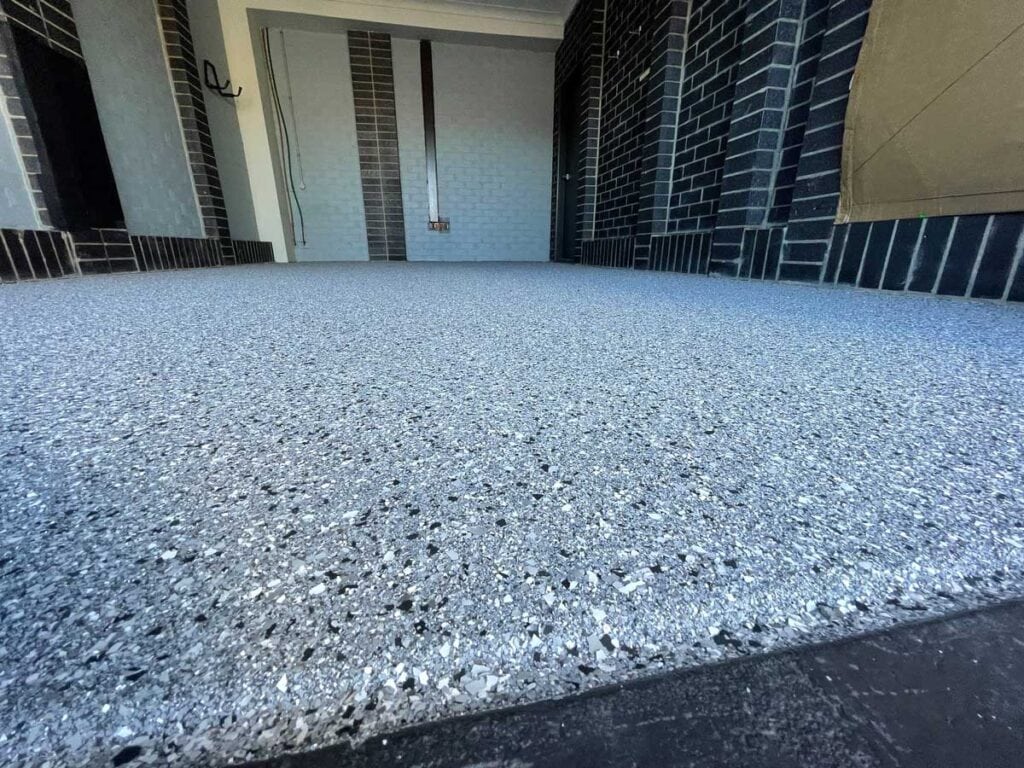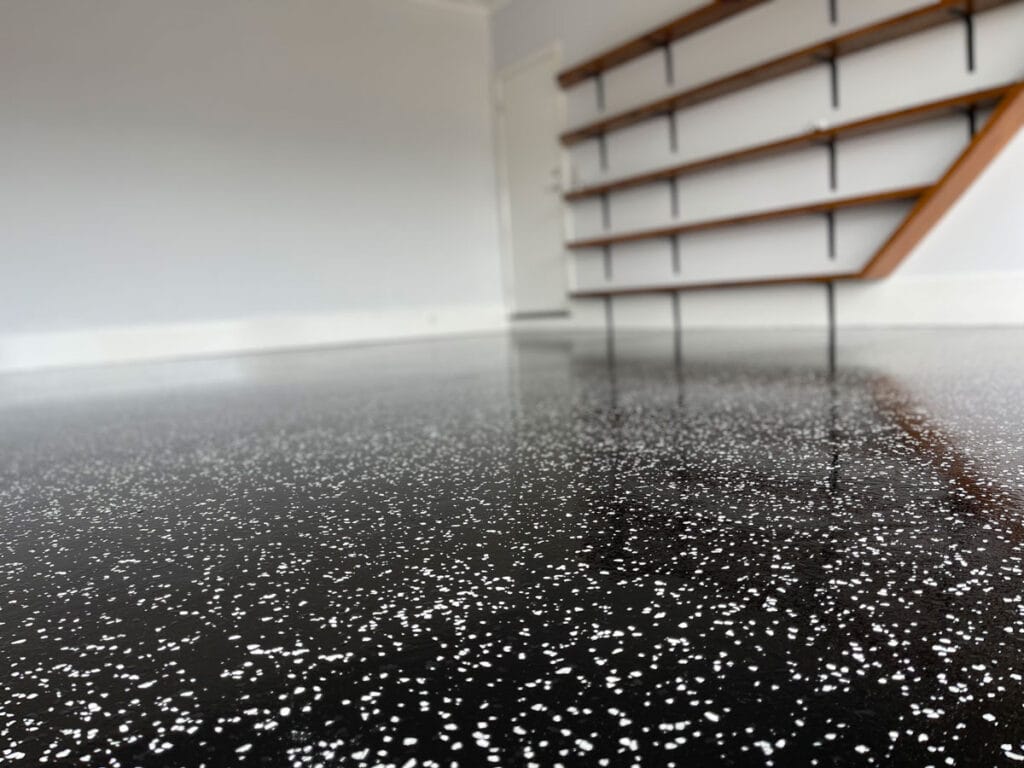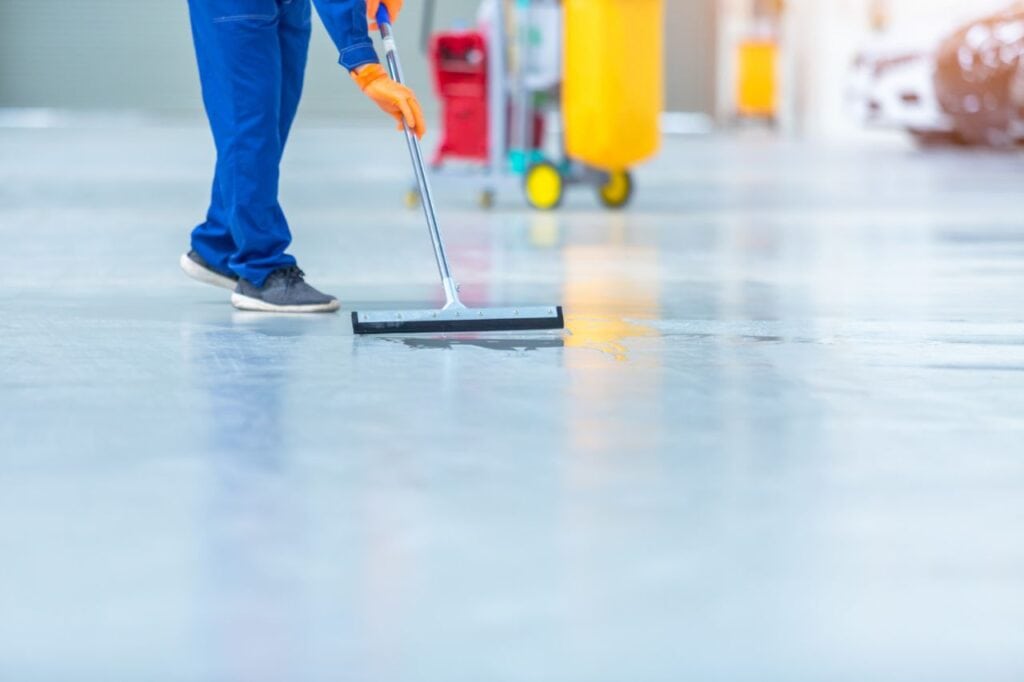You're actually asking where to begin whether you operate a production plant, a business space, or a community building that requires a different floor coating. Because there are now so many choices available, it may not be simple to choose which one is ideal for your establishment.
If you have chosen to go with a coating rather than one of the other available solutions, such as concrete polish, the next item to consider is what kind of commercial floor covering you want to use. Epoxy and polyurethane are two of the most often used alternatives. Although to the untrained observer (like in this picture, where epoxy is on the left and urethane is on the right), they can appear to be quite similar, urethane and epoxy actually have very different characteristics.
If you are looking for surface options for your workplace, resin-coated concrete floors are one of the best choices you can make. This is especially true if you operate in an industry that is highly regulated, such as the meal preparation or pharma industries.
The most important thing to consider is what kind of coating would work best for your floor. Epoxy and urethane are the two types of coatings that are most commonly used, and while both have their advantages and disadvantages, epoxy and urethane are the 2 most prevalent. In light of this, in the following paragraphs, we will examine the many possibilities by grouping them according to various standards.
Difference Between Epoxy And Urethane
Epoxy and urethane are used in a wide variety of industrial items. They can be found in items such as adhesive agents, resins, paints, foam, and curing agents, to name a few examples. They share comparable qualities in common. The distinctions between the two are important aspects that are taken into consideration by each sector's preferences.
The texture, color of a material, chemical resistance, and flexibility are some of the factors that are taken into account by industries when deciding which to utilize. There is not a major distinction to be made in regard to the cost.
Colour
The paint sector is interested in developing paint that does not fade over time. Resin manufacturing necessitates the use of chemicals that maintain their transparency. Epoxy will turn yellow after being exposed to UV light, which could take several years or months. Urethane is not affected by ultraviolet light and maintains its original color for a longer period of time than resin.
Flexibility
When it comes to adhering surfaces together, the foam and adhesive companies turn to epoxy and urethane. Both steadfastness and adaptability are necessary qualities. Epoxy, as compared to the other chemical, is a more powerful compound that stops a surface from shifting.
Epoxy is a robust material, however, it will fail on surfaces that are subject to regular movement. The flexibility of urethane is maintained. Urethane is a material that works well for buildings that shrink or expand depending on the time of year or the heat.
Chemical Make-up
Polymers include both urethane and resin in their definitions. This indicates that they are compounds composed of big molecules that have a structure that is repeated. Polyamine and epoxide are the two components that are used to make epoxy, which is a mixture of a hardener and a resin. Urethane is a compound that is made up of carbon-based or organically links that mix with an element that is recognized for its ability to form chemical bonds and is called a monomer.
Chemical Resistance
Almost every sector that makes use of urethane or epoxy materials prioritizes the substance's ability to withstand chemical exposure. It is essential to take precautions against acid or basic reactions as well as corrosion. Epoxy has a low propensity for reaction with both acids and bases. Because of this, it has a very high resistance to chemicals. To prevent reactions with urethane, acids and bases need to have their concentrations lowered. When compared to epoxy, urethane wears out more quickly.
Texture
The decision between urethane and adhesive in a given industry is made dependent on whether a chalky or smooth product is required for the application. Epoxy, when it ages, has a powdery appearance and a brittle, cracking texture. The urethane does not exhibit any roughness. Additionally, it is preferable for places or surfaces that are subjected to water.
Other Uses
Primers for auto bodies are almost always made of urethane. The consistency is ideal for filling, and it is not difficult to sand. It is possible to have a flawless body by applying it correctly. It is the most versatile primer and may be used for both covering and plastic body filler. Epoxy acts as a barrier against corrosion. Epoxy possesses excellent adherence to a wide variety of materials due to the sticky resin that it contains. When there is no need for a surface, it works wonderfully as a primer and sealer for bare metal. It is possible to paint over it after using it as a primer that does not require sanding.
Epoxy Floor Coatings
Epoxy is a thermoplastic polymer that is available in three distinct forms or formulations. It may be based on water or a fluid, or it may be completely solid. Epoxy coatings often produce a hard and long-lasting surface that binds strongly to the floor they are applied to. Epoxies are known for their durability and their ability to absorb stress, which can be beneficial for industrial surfaces that are subjected to heavy foot traffic and damage from machines.
Epoxy flooring can also be made to be extremely resistant to both chemical stains and moisture, providing it with a suitable coating for manufacturing floors and other similar enterprises. This makes epoxy flooring a good choice for coatings. In fact, epoxy is a good substance for use as a coating that may be used to resurface and renovate aged flooring.
The length of time required to install epoxy coatings is the material's most significant negative. In order to avoid the epoxy from adhering just loosely to the surface that it is designed for, the floor must be meticulously prepped. In addition, the drying period may be longer than that of other materials once the coating has been applied. Epoxy commercial coatings also have a tendency to wear down over time when they are exposed to bright sunlight, which may be a concern to consider when building a solution for a particular location that is packed with light.
Epoxy Coatings: The Pros
Epoxy floor coatings are a two-part technique that, once applied, results in a surface that is very hard and long-lasting. Epoxy coatings are resistant to stress, making them a good choice for areas of your workstation that experience a lot of foot activity. It is helpful in protecting the flooring of your facility from the long-term effects of heavy floor usage as well as from the short-term effects of driving or even falling big goods.
The adhesive is available in a wide spectrum of colors, making it an excellent option for 5S floor stripping purposes as well as the creation of attention-grabbing patterns or designs. Because of this, epoxy is a fantastic choice for creating attention-grabbing patterns or designs. Moreover, epoxy possesses remarkable resistance to the effects of contact with both water and chemicals.
Consequently, if the day-to-day operations of your business involve the use of a substantial number of liquids, this floor coating will prevent moisture from soaking into the ground, which will make cleanup much simpler and will preserve the concrete below from being damaged.
Resin is a two-part system that is exceptionally long-lasting, resilient, and resistant to moisture, pressure, and chemical hazards while still retaining its aesthetic appeal. It can do all of this while still maintaining its aesthetic quality. When it comes to striping, designing, and patterning, epoxy coatings are the material of choice. Epoxy coatings have two purposes: they shield the concrete below them from damage and stop water from seeping through.
Epoxy Coatings: The Cons
Epoxy's most significant drawback might be the length of time it takes to install it. Surface preparation is the stage that should be prioritized the most when laying an epoxy floor finish. Before the coating can be applied, the surface of the material needs to be meticulously prepared. This includes removing any and all signs of oil residues, as well as any and all prior coatings, if possible. This is due to the fact that epoxy cannot attach adequately to surfaces that have only been partially prepared, which might lead to the failure of the floor covering.
In contrast, despite the fact that an epoxy coating is durable, it is not irreversible. Even though the floor is designed to withstand severe impacts, it is still possible for it to crack or chip if an object is too big or is dropped at an angle.
Epoxy coatings' longest and most significant drawback is the length of time required to install them, the majority of which is spent on surface preparation. The concrete surface needs to be meticulously prepared, which includes completely removing all traces of oil and any prior coatings that were applied. In the event that the surface preparation is not carried out in the correct manner, the epoxy will not have a safe and stable base to attach to.
Urethane Floor Coatings
Coating concrete floors with urethane, which is also a thermoplastics polymer, is a common practice. Because of its longevity and versatility in terms of its application, it is one of the commercial coatings that performs the best overall. There are several different formulas of urethane, each of which has its own unique level of fluidity. When there is a greater percentage of solids in the mixture, the effectiveness of the covering is elevated to a higher level.
Urethane coatings are also more immune to bruises (such as falls) as well as UV light. Epoxy coatings tend to turn yellow with time, but not these coatings. They are superior in their ability to hold color and gloss, which helps the floors appear younger for a longer period of time. The preparation steps involved in applying urethane coatings take a lot less time than those involved in applying epoxy coatings. While time is of the essence, this is a crucial factor to consider when making a selection.
The fact that urethane might not form a bond to concrete that is as strong as epoxies are the fundamental disadvantage of using urethane coatings rather than commercial epoxy. Additionally, urethane has a thin surface coating, which makes it more difficult to apply the material to small fractures and other surfaces with a comparable texture.
Urethane Coatings: The Pros
Urethane floor finishes are more color-fast and resistant to abrasion than resin, making them a more durable and aesthetically pleasing option. In addition, to the above, flooring of this type is constructed to provide protection against bruises and UV rays. This floor covering would be an excellent option for you to go with if you run an industrial building that sees a high volume of foot traffic on a daily basis.
Urethane can be put in a clear coat, which allows the natural textures and shades of the floor beneath it to be seen. However, it can also be purchased in a broad variety of colors to choose from. Prepreg for urethane paints and coatings is typically a technique that is not as labor-intensive as the coating application itself. Since epoxy and urethane both have the ability to adhere to earlier finishes, it is not necessarily necessary to remove any existing coats before installing urethane.
Urethane Coatings are a fantastic option for use in manufacturing and warehouse spaces. Urethane, which is a shorter form of the word polyurethane, starts off as a liquid resin but hardens into an exceptionally durable and resistant surface. Coatings made of urethane are robust, long-lasting, and resistant to abrasion. In addition to this, they are resistant to corrosion when put in contact with particular types of chemicals. Because urethane coatings last for a longer period of time than epoxy coatings do, they are an excellent choice for industrial or commercial establishments that see a great deal of foot or wheel activity.
Additionally, urethane has one of the best life expectancies available; it may be 10 years before a new layer needs to be applied. This makes it an excellent choice for flooring. Last but not least, urethan can be tailored to your own preferences and requirements. It can have a pigmented finish or be clear, and it is resistant to chipping and scratches, so it won't lose any of its visual appeals.
Urethane Coatings: The Cons
Even while the material preparation for applying urethane coverings may not have to be as comprehensive as it does when applying epoxy, the process of installing urethane coatings can still take quite a bit of time. Nevertheless, you are left with a production network floor that is long-lasting, almost indestructible, and extremely durable.
Even if the surface preparation might not be as laborious as it is for epoxy coatings, there will still be some delay.
Epoxy Coatings vs Urethane Coatings – Which Is The Best Choice For Your Business’ Flooring?
Floor Coating Pricing
In most cases, price is not a primary consideration. When constructing or upgrading a working area, it is possible to apply epoxy and urethane finishes, and doing so does not put a significant financial strain on the project. Epoxy is typically less expensive than urethane, but the price difference is not likely to be significant enough to have a significant impact on the choice that you make.
Epoxy Vs Urethane Coating Strength
Both urethane and epoxy possess impressive levels of tensile strength, albeit in somewhat dissimilar methods. Epoxy is more immune to crushing impacts and is physically stronger than other materials, such as when they are run over by big vehicles. The use of an epoxy coating is recommended for areas that will be subjected to a significant amount of heavy foot traffic. However, due to its fragility, it can be easily broken by falling items, particularly those with pointed or angular corners or points.
The urethane floor layer is not quite as impervious to pressure from below, but because of its rubbery nature, it is more durable against harm caused by falling objects. It also has a higher resistance to heat, unlike epoxy, which can become brittle when exposed to temperatures that are sufficiently high.
Floor Coating Installation Time
The installation of urethane and epoxy will together require some time to complete. Before the thin layer can be placed, the concrete floor needs to be prepared. This entails first removing any and all contaminants from the surface of the floor, followed by drying it completely. The coating will require a significant amount of time in order to fully solidify and cure.
Even while urethane dries and cures more quickly than epoxy, the installation process will still take at least two days regardless of which material is used. On the other hand, the drying period for epoxy can sometimes be as long as three days before it can be used. Epoxy is also more susceptible to damage from exposure to high levels of humidity and moisture. Therefore, even negligible levels of moisture might make the drying process take significantly longer.
Chemical Resistance Of Epoxy Vs Urethane Flooring
Epoxy is likely to be the superior choice in situations where there is a considerable risk of chemical spillage. When compared to urethane, it exhibits superior resistance to both acids and bases. Urethane cement floors will become less durable if it is frequently exposed to practically any caustic material. Epoxy coatings can also be blended with other chemicals to add extra chemical resistance against specific spills when it appears likely that this would occur. This can be done in a laboratory setting.
Flooring Cleanliness And Microbial Resistance
Excellent coatings that are simple to maintain can be achieved with urethane and epoxy, respectively. Because they are laid out across the entirety of the floor, they produce a surface that is uninterrupted from edge to edge and completely adapts to the topography of the floor. This includes any structural aspects, such as columns, that may be present.
As a consequence of this, there are no crevices or seams in the flooring that may potentially provide a breeding ground for mold, mildew, or other types of germs. Furthermore, the floors can be readily cleaned using fundamental methods. Additionally, epoxy can be combined with a variety of different chemicals, such as silver, which also increases the antibacterial capabilities of the material.
Ultraviolet (UV) Resistance
The urethane floor finishing is without a doubt the most advantageous option here. Epoxy will quickly lose its color and fade when exposed to direct sunshine, and it can become more fragile when exposed to frequent fluctuations in temperature, such as when moving in and out of the sunlight. On the other hand, ultraviolet light has absolutely no effect whatsoever on urethane. Because of this, urethane is the material of choice when it comes to applications like entry foyers in commercial establishments that have a lot of windows.
Coating Texture And Traction
Urethane and resin, despite the fact that they produce a clean finish due to their high light reflectivity, are perfectly safe to walk on under ordinary circumstances and offer a great deal of grip. Epoxy, on the other hand, has a propensity to become highly slick when wet, which could also create a risk of stumbling over it.
In certain circumstances, this may even go against the safety requirements established by OSHA. Because of this, it is essential to choose the appropriate material for the specific use cases, whether it be for the floors of an industrial or commercial facility.
It really is possible to improve the adhesive properties of epoxy by adding sand or other materials like that. Nevertheless, this results in an increase in expense. Because non-caustic spills are likely to occur, like those that might occur in grocery shops, urethane is a superior choice for non-slip surfaces.
Visual Appeal
Both urethane and basic adhesive will result in floors with a comparable glossy appearance. Epoxy, on the other hand, is a great choice if you're going for aesthetic appeal. Epoxy can be infused with metallic particles to produce swirls that have a lot of depth in addition to being visually appealing. In addition to this, urethane can be produced in a wide range of colors.
Epoxy Vs Urethane Concrete Floor Installation
In the end, the decision between epoxy and polyurethane coatings comes down to a trade-off between great abrasion resistance and tight attachment to the floors. If you are additionally concerned about the product's resistance to stains caused by water or chemicals, its simplicity of application, and its capacity to withstand the effects of UV light, you may be compelled to choose one choice over another.
The topic of which material, epoxy or urethane, is "better" does not have an easy answer because there is no clear winner. The proper floor is one that is tailored to the setting, although either seamless option will provide a floor system that is more durable than the other.
Summary
Selecting a new surface for your commercial or business area can be a difficult prospect; choosing a sealant for that floor can be much more challenging. There are a lot of different elements to take into account, and you'll want a surface that is tailored to the specific requirements of your company.
The fact that floor coverings and elements can be complicated, and the variations amongst each system are frequently not immediately apparent to the naked eye, does not help matters. Coatings made of urethane and epoxy behave in the same manner in this regard. They each have advantages and disadvantages, but they are also compatible with one another, which we shall go over in more detail later.
In order to achieve the perfect combination, some people choose to combine epoxy and urethane in a single coating by applying a coat of urethane on top of the epoxy. Having trouble deciding which option is best for your establishment? You can talk to one of our flooring specialists about figuring out which option is the most suitable for your requirements.
So which of these options should you choose? Urethane could be the best option for you if you want a truly hard ground that you won't have to touch up for decades, or if the floor of your facility gets a battering every day and you need a covering that can keep up with it.
Adhesive, in contrast, could be the best option for you if you run a large enterprise that does not require the hardcore protection offered by urethane or if you are searching for a structure for your floor. Both of these scenarios indicate that you do not require the level of protection offered by urethane. Last but not least, you could want to think about employing them both together. There are occasions when resin and urethane are used together, with the urethane being layered on top of the epoxy. Concepts In Concrete is delighted to assist you in making a decision regarding the type of system that will best meet your needs.
FAQs Epoxy And Urethane
What Is The Difference Between Epoxy And Urethane Paint?
When compared to epoxy, urethane is more resistant to the effects of ultraviolet light, which means that the color of the painting will not fade as quickly. Because epoxy is not resistive to ultraviolet light, paint formulations that contain epoxy frequently change color as soon as they are applied. When it comes to the flexibility features, epoxy and urethane both have a number of benefits over other materials.
Should You Choose Epoxy Or Urethane Coating For Your Floors?
In the end, the decision between epoxy and urethane coatings comes down to a trade-off between great abrasion resistance and tight adhesion to the floors. If you are additionally concerned about the product's resistance to stains caused by water or chemicals, its ease of installation, and its capacity to withstand the effects of UV light, you may be compelled to choose one choice over another.
The question of which material, epoxy or urethane, is "better" does not have a straightforward solution. The proper floor is one that is tailored to the setting, although either seamless option will provide a floor system that is more durable than the other.
Why Are Epoxy And Urethane Used In Industrial Products?
Epoxy or urethane materials may be utilized in the manufacturing process of a variety of industrial goods, including paints, foam, resins, adhesive agents, and curing agents. We are able to manufacture these helpful industrial products because we have access to these components. For instance, we would not be able to turn the world into a more colorful place to live if we did not have access to paints.
What Are The Most Common Problems With Epoxy And Urethane?
The most typical issues that arise while using epoxy and urethane in installations are. Cavities in the molds as a result of defects caused by shrinking. The most typical issues that arise while using epoxy and urethane in applications are. The well-designed component makes it possible to have a wall thickness that is rather homogeneous throughout the encapsulant.
During the production of cement, the sections that are thicker begin to solidify first, and the material that is shrinking will refill itself from the places that have not been cured to almost the same level as the rest of the surface.
What Are The Most Common Problems With Epoxy?
The following is a list of some of the most typical issues that arise with epoxy, as well as possible solutions to these issues. Eyes of fish: Epoxy that has been stretched and spread too thinly might develop imperfections that look like fish eyes. They are identified by a crater in the material, with a dot in the center of the hole. To prevent the appearance of fish eyes, you should ensure that you purchase more epoxy than is necessary to cover the area you intend to coat.
Typically, epoxy flooring lasts 2 to 3 years in heavy traffic. Commercial properties—like garages, restaurants, or factory spaces—with lots of daily foot traffic can expect this experience. However, with proper care and maintenance, your epoxy flooring may last much longer.
- Strong Application Fumes. During the epoxy application process, wet epoxy gives off an unpleasant smell. ...
- Long Curing Time. ...
- Slippery When Wet. ...
- Economical Flooring Choice. ...
- Resistant to Damage. ...
- Weather-withstanding. ...
- Aesthetically Pleasing. ...
- Protects and Decreases Wear & Tear.
Extremely safe – Epoxy is a very safe coating for your hard floors. It's slip resistant, shock resistant, and less abrasive than concrete and other types of industrial flooring. ... It can also withstand heat of up to 200 degrees, making it a better choice than most other types of flooring when it comes to fire resistance.
